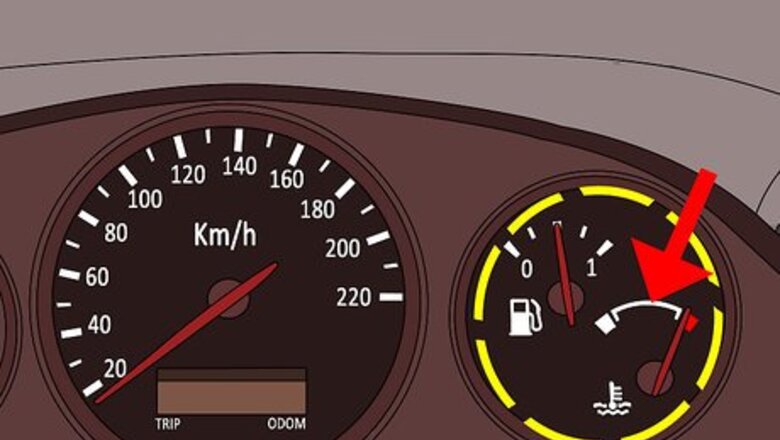
views
Identifying a Leak in Your Radiator
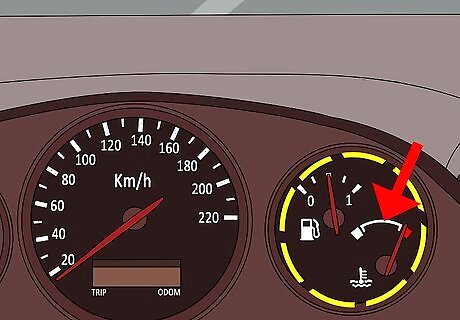
Look for a rise in the temperature gauge. Your radiator dissipates heat to help maintain the optimal operating temperature for your vehicle’s engine. A leak in your radiator will result in lost coolant, which will compromise the system’s ability to reduce that temperature. When your coolant system begins to fail, the temperature gauge on your dash board will climb. If your vehicle has been running consistently warmer or if you have recently begun having issues with overheating, you may have a leak in your radiator. Remember that overheating can cause serious damage to the engine in your vehicle. Stop driving immediately if your vehicle begins to overheat. If your vehicle has been running hotter than usual, you may have a slow leak, as there is still enough coolant in the system to keep the engine cool enough to operate.
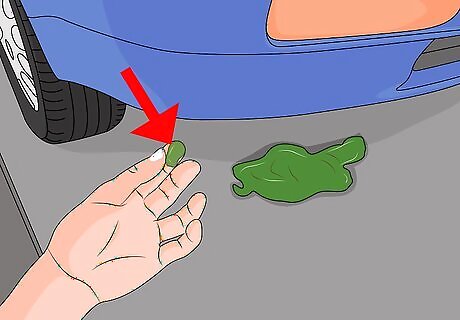
Take note of puddles under your vehicle. An easy way to identify a coolant leak is to notice when puddles of coolant form under your vehicle. Of course, there are a number of fluids in a vehicle’s engine that may leak, so you will need to look closely and possibly even touch the fluid in order to properly identify it. Remember that driving with your air conditioning on will result in moisture dripping from your A/C compressor and that vehicles are just as prone to oil leaks as they may be to coolant ones. If you notice a puddle under your vehicle, or where your vehicle used to be parked, look closely at it. Coolant has a green or orange hue to it and should look quite different from motor oil or water. New motor oil may be yellowish, but if it’s been in your engine for a while it will likely be dark brown or even black. Dripped condensation from your air conditioning will just be water.
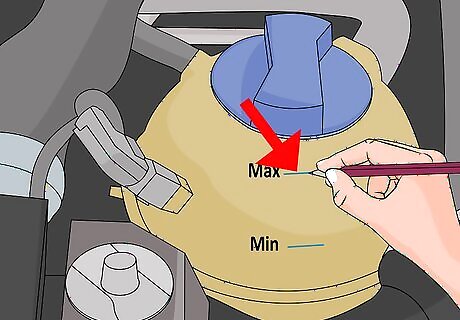
Check your coolant reservoir. If you suspect that you may have a leak in your radiator that you haven’t been able to identify, make note of the coolant level in the coolant reservoir under the hood. Most coolant reservoirs will have low and high fill marks clearly indicated. Draw a line on the reservoir with a paint pen or take a picture of it with your phone to remember the level the fluid is at upon your first inspection. Open the hood and check again after a few hours of driving to see if the level has gone down. If you did the initial check with the engine cold, wait for it to cool again before rechecking. Coolant remains in the sealed system and the level should not change. If the coolant level is lower upon your second inspection, it means that there is a leak somewhere.
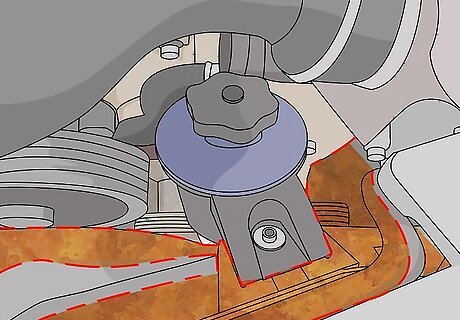
Visually inspect the engine bay. If you notice more rust and discoloration on the parts surrounding your radiator or on the radiator itself, that may be an indication that there is a coolant leak in the radiator in that vicinity. As the leak permits the coolant and water to escape the radiator while you’re driving, it encourages rust to develop on the parts it comes into contact with. While all engine components can be subject to rusting, if you notice an area with an inordinate amount of it near your radiator, there may be a leak there. Look for signs of coolant around rust spots that you identify. You may be able to find the leak by following any coolant in these rusty areas to their highest point.
Locating the Leak
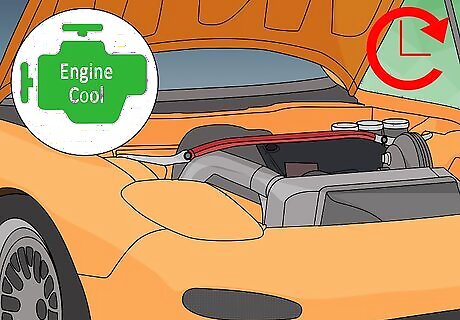
Allow the engine to cool. Your radiator has the important task of helping to maintain the operating temperature of the engine. As a result, the radiator and coinciding lines can become extremely hot. While hot, the coolant system is pressurized, so removing the radiator cap can expel heated coolant and steam that can be dangerous. Pull the car into the space or garage bay that you will be working on it from and allow it to cool for a few hours before beginning this project. Open the hood after you park the vehicle to allow the heat to dissipate unimpeded. Be prepared to wait for a few hours for your engine to cool enough to work on.
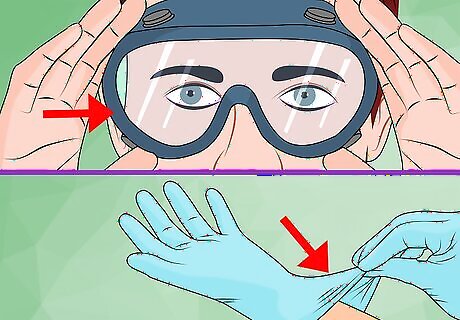
Put on the appropriate safety gear. Because coolant systems are pressurized, it’s important to wear safety glasses when working on your radiator. Although the engine should be cool to the touch before you proceed, coolant systems can be under a great deal of pressure and may expel gas when you open the cap. You also may need to climb under the car at some point during this project and safety glasses will protect your eyes from falling debris that is caught in the vehicle’s undercarriage. Always wear safety glasses when working under the vehicle. You may also choose to wear gloves to protect your hands from pinches and any remaining heat.
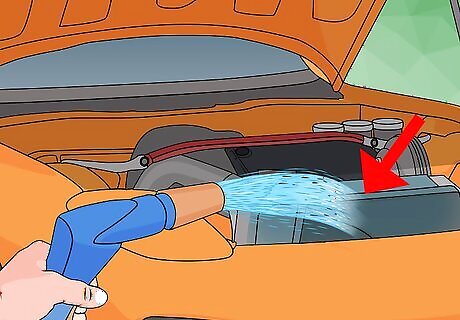
Wash the radiator with a hose. It will be much easier to locate the leak in your radiator after it’s clean of old grime and coolant. Use a hose to spray the radiator and surrounding components so you can know for sure that any new coolant you see in the engine bay after you start the car has leaked since you washed it. As you wash the radiator, look for any signs of cracks in the radiator itself or on either of its end tanks. It is unnecessary to use soap when washing your radiator. Use paper towels to wipe away any areas of excessive grime.
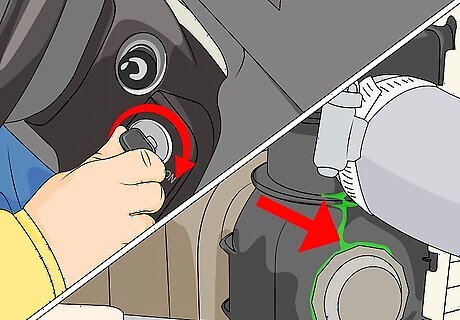
Start the car and look for new signs of leaks. One of the two methods you can use to identify a leak in your radiator is to start the engine once it’s clean. With the engine running, look closely at your radiator and at the surrounding engine for signs of a leak. You may see steam or fluid spraying out of a leak, coolant or water dripping down the radiator or piping, or hear the hissing of a leak that you aren’t able to see from your vantage point. This method can help to point you in the right direction, but may require you to shut the car off again to gain visibility on harder to spot areas of the radiator. Look for fluid or gas spraying from cracks in the radiator. Look for drops of coolant running downward from a leak above them. Listen for hissing coming from the area around the radiator for leaks you can’t see.
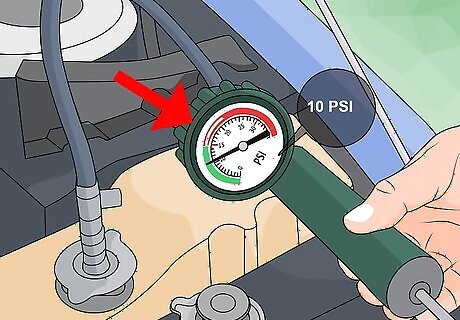
Use a pressure tester to locate leaks. You can purchase a coolant system pressure tester at your local auto parts store. To use it, make sure the engine is cool and remove either the radiator or pressure cap from your coolant system. Install the tester in place of the cap using the included adaptor. Once the tester is secured and the system is once again sealed, use the tester to pump ten pounds of pressure into the coolant system. When the gauge indicates a loss of pressure, that means the pressure is currently leaking from the system. Follow the sound of the air leaking from the crack to locate it. Be careful not to add more than 10 to 15 pounds of pressure (psi) to your coolant system. More than that could result in damage and even create more leaks. Your cooling system operating pressure should be listed on the radiator cap and you shouldn't exceed this number by much when pressure testing. Look for any leaks that may be present on coolant lines as well as the radiator as they may be susceptible to cracking over time.
Repairing a Coolant Leak
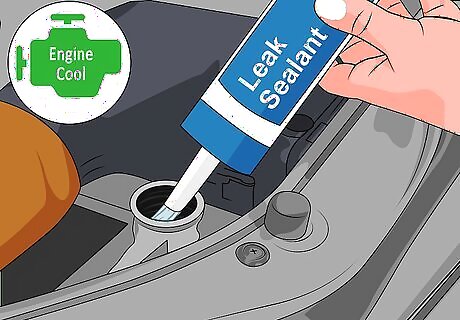
Use a commercial leak sealant. There are a number of products on the market designed to make sealing a leak in your radiator simple and easy. Although there are multiple brands, the methodology of these leak sealant products is fairly universal. Start by ensuring the engine is off and cool. Remove the radiator cap and pour the contents of the leak sealant directly into the cooling system. Top it off with a coolant and water mixture if your vehicle’s engine is currently low. Replace the radiator cap and start the engine. The leak will seal as the sealant makes its way through your coolant system. This method is not as permanent as professional radiator repair or an epoxy, but will suffice to seal small leaks until more permanent repairs can be made. Allow the engine to run for 5-10 minutes while the stop leak product makes its way through the coolant system. After running it, allow the engine to sit overnight as the sealant sets.
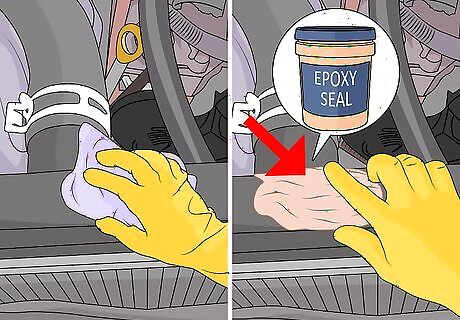
Use epoxy to seal visible cracks. When you identify a visible crack, clean the area around it thoroughly. Any remaining grease or dirt in the area may prevent the epoxy from establishing a seal. Use a brake cleaner and a rag to help you remove stuck on grime. Once the area is clean, allow it to dry completely before attempting to use the epoxy. Knead the epoxy in your hand until it becomes malleable enough for you to spread it out over the crack. Remember to be thorough and to keep the epoxy at least an eighth of an inch thick so it can withstand the pressures of the coolant system when the vehicle is running. You can purchase radiator epoxy at most auto parts stores. Allow the epoxy to set overnight before starting the vehicle.
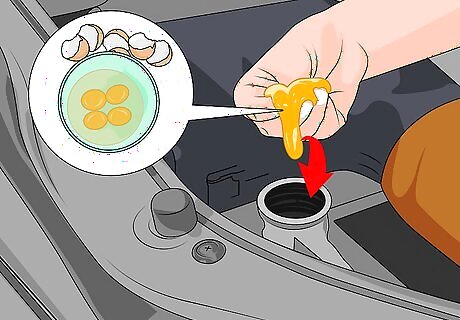
Use an egg to seal a leaky radiator. Eggs are not a good long term solution, but they can actually seal pinhole leaks in your radiator until you are able to have it properly repaired. Start by separating the egg yolks from the whites. Discard the whites, then put the yolks from three or four eggs into your coolant system through the radiator cap. Start the engine just as you would with a leak sealant and allow the egg yolk to travel through the coolant system. The yolks will congeal and seal small leaks in your radiator and allow it to hold pressure long enough to get you home or to a garage to have repairs done. Using egg yolks could potentially lead to clogs in your coolant lines and is not recommended except in emergencies. This method is less reliable than the commercial products you can use to permanently repair your radiator.
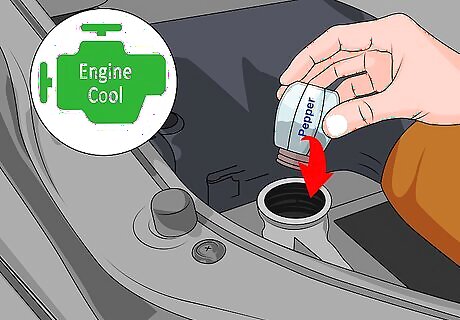
Use pepper to seal small leaks. Pepper is another unlikely tool you can use to slow or stop a small leak in your radiator long enough to make it home or to a garage for repairs. Wait for the engine to cool completely, then open the radiator cap and pour in about a half a pepper shaker’s worth of common black pepper. The pepper, like sealant or egg yolks, will travel through the coolant system and get caught in the crack as the pressure tries to flush it out. This will create a temporary seal that you can use to hold coolant and pressure long enough to drive for a short time. Like egg yolks, this method is not recommended unless you are in an emergency and is less reliable than commercial products. Pepper may be able to seal longer cracks than egg yolks, but is only recommended for small leaks.
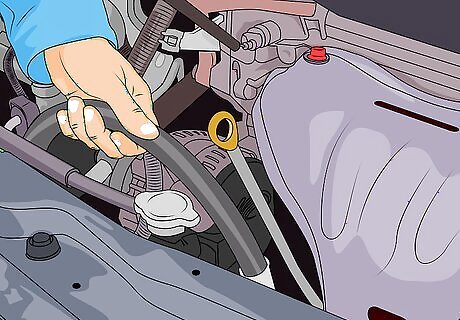
Check on your repair. Regardless of the method you used to seal the leak in your radiator, it’s important that you check on the repair once you’ve given it an opportunity to set. After driving the vehicle for a short time, keep an eye out for signs of leaking. If you believe you may still be leaking coolant, conduct the same tests to try to identify the source of the leak. There may be multiple leaks or your repair may not have sufficiently sealed the system. Identify any new leaks and repeat the process. Egg yolks and pepper are not meant to be permanent solutions to a radiator leak. Consider using a leak sealant or epoxy to sure up the repair once you make it home. Significant cracks may be beyond repair. In those cases, your radiator will likely need to be replaced. Make sure to refill your coolant system with a 50/50 water and coolant mix any time it is low. EXPERT TIP Hovig Manouchekian Hovig Manouchekian Auto Repair & Design Specialist Hovig Manouchekian is an Auto Repair and Design Specialist and the Manager of Funk Brothers Auto, a family-owned business operated since 1925. With over 30 years of experience in the automotive industry, Hovig specializes in the process of auto repair and maintenance. He is also very knowledgeable in common automotive issues and needs including engine repair, battery replacement, and windshield accessory and maintenance. Hovig's knowledge and hard work have contributed to Funk Brothers Auto winning Angie's List Super Service Award for five consecutive years. Hovig Manouchekian Hovig Manouchekian Auto Repair & Design Specialist Be sure to accurately measure your current radiator before buying a replacement. Use a tape measure to determine the radiator core's length, width, and depth. Also, note the number of core rows (horizontal channels) in the radiator. Aim to find a replacement with the same or more core rows to ensure optimal cooling efficiency.




















Comments
0 comment